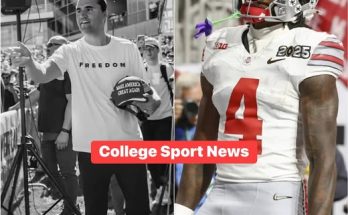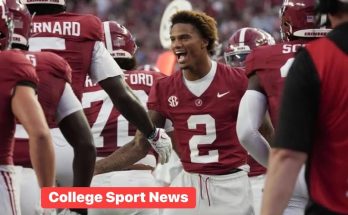Nebraska had a day through the air, and for a program that has often been associated with ground-and-pound, smashmouth football, it felt like a breath of fresh air and a glimpse into what the future of the program could become. Fans who have lived through years of inconsistent quarterback play, conservative passing concepts, and a heavy reliance on the run were treated to something they have been craving: explosive, dynamic, and fearless passing that stretched the field, attacked every level of the defense, and reminded the college football world that the Cornhuskers are capable of evolving with the times. It was not just about the stats, although those numbers were impressive, but about the way Nebraska played, the confidence in its quarterback, and the rhythm the entire offense found when leaning into the passing game. The narrative surrounding Nebraska has been one of rebuilding and of trying to climb back into national relevance, and games like this provide a spark of hope that the program is finally embracing the type of balance and aggressiveness necessary to compete with the best.
From the opening drive, there was a clear message that Nebraska was going to put the ball in the air and trust its quarterback to make decisions. The timing between the quarterback and his receivers was sharp, the routes crisp, and the protection strong enough to let plays develop. Fans who have followed Nebraska closely could sense a different energy. Instead of playing not to lose, the Huskers were playing to dominate, attacking vertically and horizontally, making the opposing defense uncomfortable from the start. The deep shots were not forced but calculated, and when they connected, the stadium roared with a kind of energy that has been absent for too long. Even the short and intermediate throws carried purpose, setting up yards after catch opportunities and giving Nebraska’s receivers room to showcase their speed and creativity. It was a reminder that football is not only about execution but also about attitude, and Nebraska’s passing attack carried a swagger that fed into the entire team’s confidence.
What made this performance particularly striking was how balanced and creative the passing game appeared. Nebraska did not simply drop back and throw to the same target repeatedly; instead, the quarterback spread the ball around to multiple receivers, backs, and tight ends, forcing the defense to account for every eligible player on the field. That type of distribution builds chemistry and trust within an offense, as players know that if they run their route hard, there is a chance the ball could come their way. It also made it nearly impossible for the defense to key on one star player, because Nebraska’s attack was multidimensional. The tight ends were involved in seam routes, the slot receivers made big plays across the middle, and the outside threats stretched the field with highlight-worthy catches. Each drive showcased a new wrinkle, and that unpredictability kept the defense off balance all day long.
Fans of Nebraska have often felt a tension between tradition and progress. The program’s legacy is rooted in dominant offensive lines, punishing running games, and controlling the trenches. But the modern era of college football requires versatility and explosive passing to win at the highest level. Saturday’s performance through the air showed that Nebraska does not have to abandon its roots to evolve. Instead, it can embrace the passing game as a weapon that complements its physical identity. When the Huskers were slinging the ball around with success, their run game opened up naturally, because defenders had to respect the passing threat and could no longer stack the box. That balance created a harmony on offense that Nebraska has not consistently achieved in years, and it demonstrated the potential of what this team could become when everything is clicking.
It is important to recognize how much of this breakthrough performance comes down to quarterback play. For years, Nebraska fans have debated whether their team has the right player under center to lead them back to prominence. A quarterback who can execute the offense, make quick reads, protect the football, and create explosive plays is not just a luxury but a necessity in today’s game. On this particular day, Nebraska’s quarterback looked like he belonged among the best, delivering throws with accuracy, anticipation, and confidence. He was decisive in the pocket, showed poise when under pressure, and even when forced to improvise, he turned broken plays into big gains. That type of performance not only energizes the fan base but also builds trust within the locker room, as teammates rally around a leader who delivers in big moments. It is difficult to overstate how critical strong quarterback play is for Nebraska’s future, and this game could mark a turning point in that journey.
Beyond the quarterback, credit must also go to the wide receivers, who put together their most complete performance of the season. For a group that has often faced criticism for drops, inconsistency, or failing to separate from defenders, this was a statement outing. The receivers ran sharp routes, won contested catches, and showed the ability to turn short passes into long gains. Their effort extended plays, gave the quarterback confidence, and kept drives alive. Several players emerged with highlight moments, from toe-tapping sideline grabs to acrobatic high-point catches in traffic. The chemistry between the quarterback and his receivers felt like it had taken a leap forward, the type of growth that can carry over into future games. For fans who have longed to see Nebraska’s skill players shine in the passing game, this performance was validation that the talent is there and ready to be unlocked.
The offensive line, often overlooked when discussing passing success, deserves its share of recognition as well. Protection has been a sore spot for Nebraska in recent seasons, with too many sacks and pressures disrupting any rhythm the offense tried to establish. But on this day, the line held strong, giving the quarterback time to survey the field and make clean throws. There were moments of breakdown, as there always are in football, but for the most part the protection was reliable and sturdy. That stability in the trenches allowed the play-calling to open up, as coaches could trust that deeper-developing routes would have time to unfold. It was a collective effort that highlighted how each unit must work in sync for a passing attack to flourish, and Nebraska’s line showed significant growth in this regard.
Defensively, Nebraska also benefited from the offensive fireworks. When an offense is clicking and consistently putting points on the board, it changes the way the defense can play. The Huskers’ defenders looked energized, flying around the field and feeding off the momentum created by the offense’s success. Opponents were forced to play from behind, abandon their preferred game plan, and take risks to keep pace with Nebraska’s scoring. That shift allowed the defense to attack more aggressively, pinning its ears back and creating turnovers. The symbiotic relationship between offense and defense was on display, and the aerial show from the offense set the tone for the entire team’s dominance.
For Nebraska fans, this game will be remembered not just as a win but as a symbol of what is possible. After years of frustration, inconsistency, and searching for an identity, there is a renewed sense of excitement about the direction of the program. The passing performance was not a fluke or a lucky break but the result of preparation, execution, and belief in a system that rewards aggressiveness. The challenge, of course, is to sustain this momentum. One explosive game is not enough to declare a turnaround, but it is a critical step in building confidence and setting a standard for what Nebraska football can aspire to week in and week out. If the Huskers can replicate this type of passing efficiency and continue to develop their offensive identity, the future suddenly looks brighter than it has in a long time.
The cultural impact of a game like this cannot be understated. Nebraska football carries a weight of expectation that few programs can match, with a fan base that lives and breathes every play. When the team delivers an electrifying performance through the air, it does more than put points on the scoreboard—it restores pride, sparks conversations, and re-energizes a community. Alumni, boosters, and casual fans alike take notice, and recruits who may have questioned Nebraska’s offensive vision now see a system they might want to be a part of. Momentum is a powerful force in college football, and a performance like this has ripple effects that extend far beyond the final score.
The bottom line is that Nebraska had a day through the air, and it was about much more than one afternoon of football. It was about rewriting narratives, silencing critics, and proving that this program is capable of adapting and thriving in the modern game. It was about players stepping up when their number was called, coaches trusting their schemes, and fans being rewarded for their unwavering loyalty. Whether it becomes a turning point in the season or simply a memorable chapter in the ongoing story of Nebraska football, it will be remembered as the day the Huskers lit up the sky with a passing attack that demanded attention. In a sport where momentum and perception mean everything, Nebraska just reminded the college football world that they are not stuck in the past—they are ready to soar into the future.



